Report: Business Resources and Finance in the ASDA Organization
VerifiedAdded on 2020/06/04
|9
|3193
|57
Report
AI Summary
This report analyzes the business resources of ASDA, a leading supermarket chain. It begins with an overview of recruitment documentation, including job descriptions, personal specifications, and application forms. The report then explores employability, personal, and communication skills essential for various job roles within the organization. It delves into the physical and technological resources required for ASDA's operations, such as buildings, shelves, software, and insurance. Furthermore, the report examines internal and external sources of finance, including owner's savings, profits, bank loans, and building societies. It also explains the contents of trading, profit and loss accounts, and balance sheets, along with the use of budgets for financial control. The report concludes with a discussion of the financial state of a given business, providing a comprehensive understanding of ASDA's resource management and financial strategies.
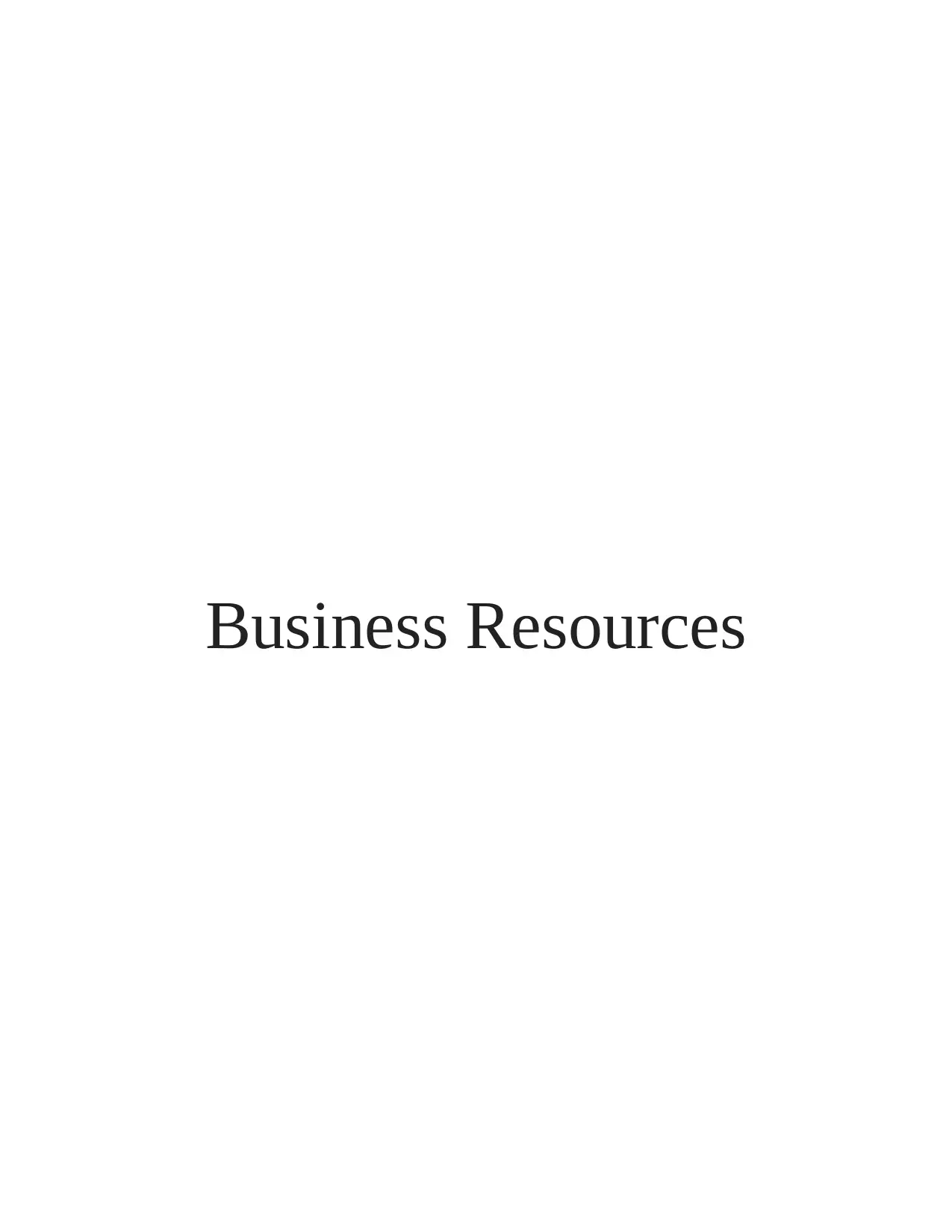
Business Resources
Paraphrase This Document
Need a fresh take? Get an instant paraphrase of this document with our AI Paraphraser
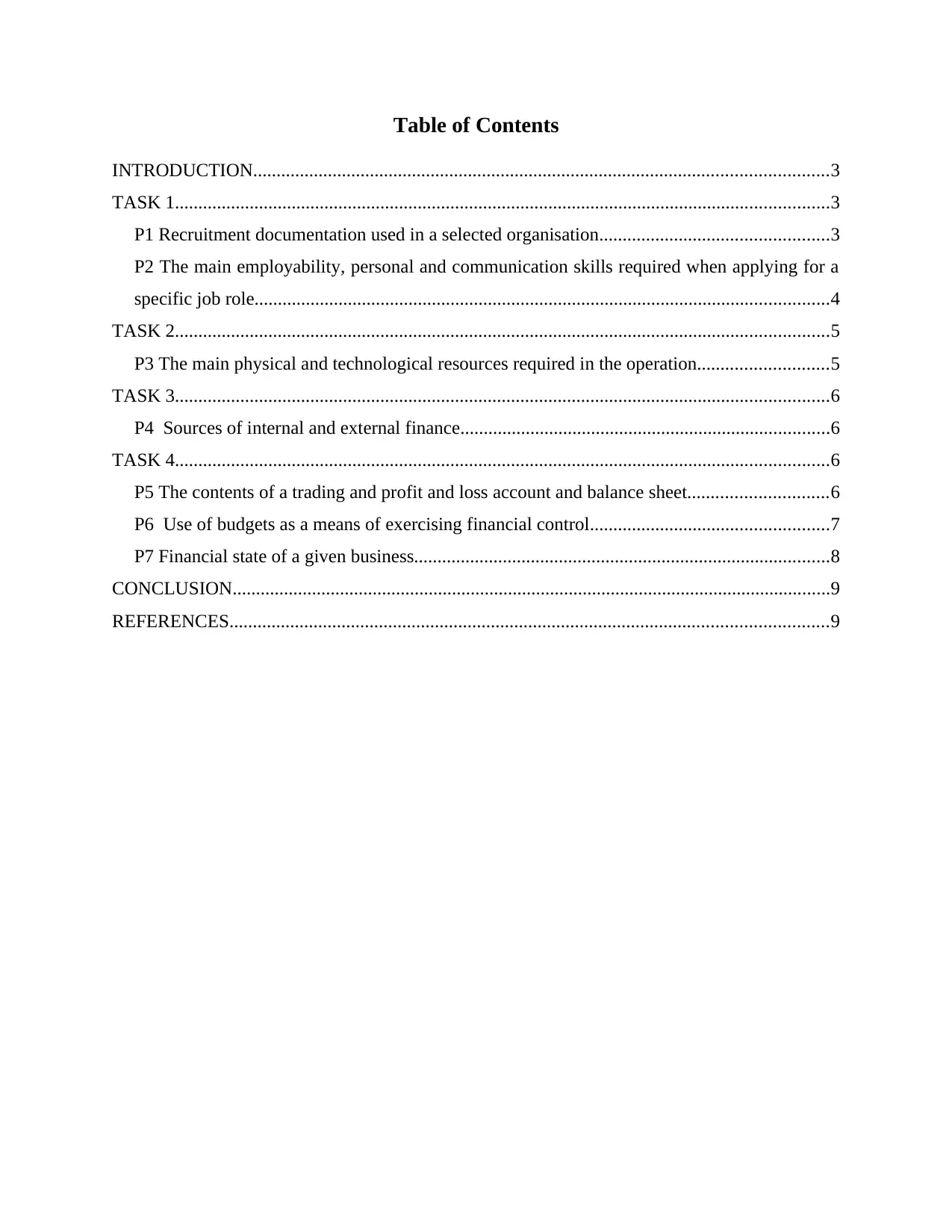
Table of Contents
INTRODUCTION...........................................................................................................................3
TASK 1............................................................................................................................................3
P1 Recruitment documentation used in a selected organisation.................................................3
P2 The main employability, personal and communication skills required when applying for a
specific job role...........................................................................................................................4
TASK 2............................................................................................................................................5
P3 The main physical and technological resources required in the operation............................5
TASK 3............................................................................................................................................6
P4 Sources of internal and external finance...............................................................................6
TASK 4............................................................................................................................................6
P5 The contents of a trading and profit and loss account and balance sheet..............................6
P6 Use of budgets as a means of exercising financial control...................................................7
P7 Financial state of a given business.........................................................................................8
CONCLUSION................................................................................................................................9
REFERENCES................................................................................................................................9
INTRODUCTION...........................................................................................................................3
TASK 1............................................................................................................................................3
P1 Recruitment documentation used in a selected organisation.................................................3
P2 The main employability, personal and communication skills required when applying for a
specific job role...........................................................................................................................4
TASK 2............................................................................................................................................5
P3 The main physical and technological resources required in the operation............................5
TASK 3............................................................................................................................................6
P4 Sources of internal and external finance...............................................................................6
TASK 4............................................................................................................................................6
P5 The contents of a trading and profit and loss account and balance sheet..............................6
P6 Use of budgets as a means of exercising financial control...................................................7
P7 Financial state of a given business.........................................................................................8
CONCLUSION................................................................................................................................9
REFERENCES................................................................................................................................9
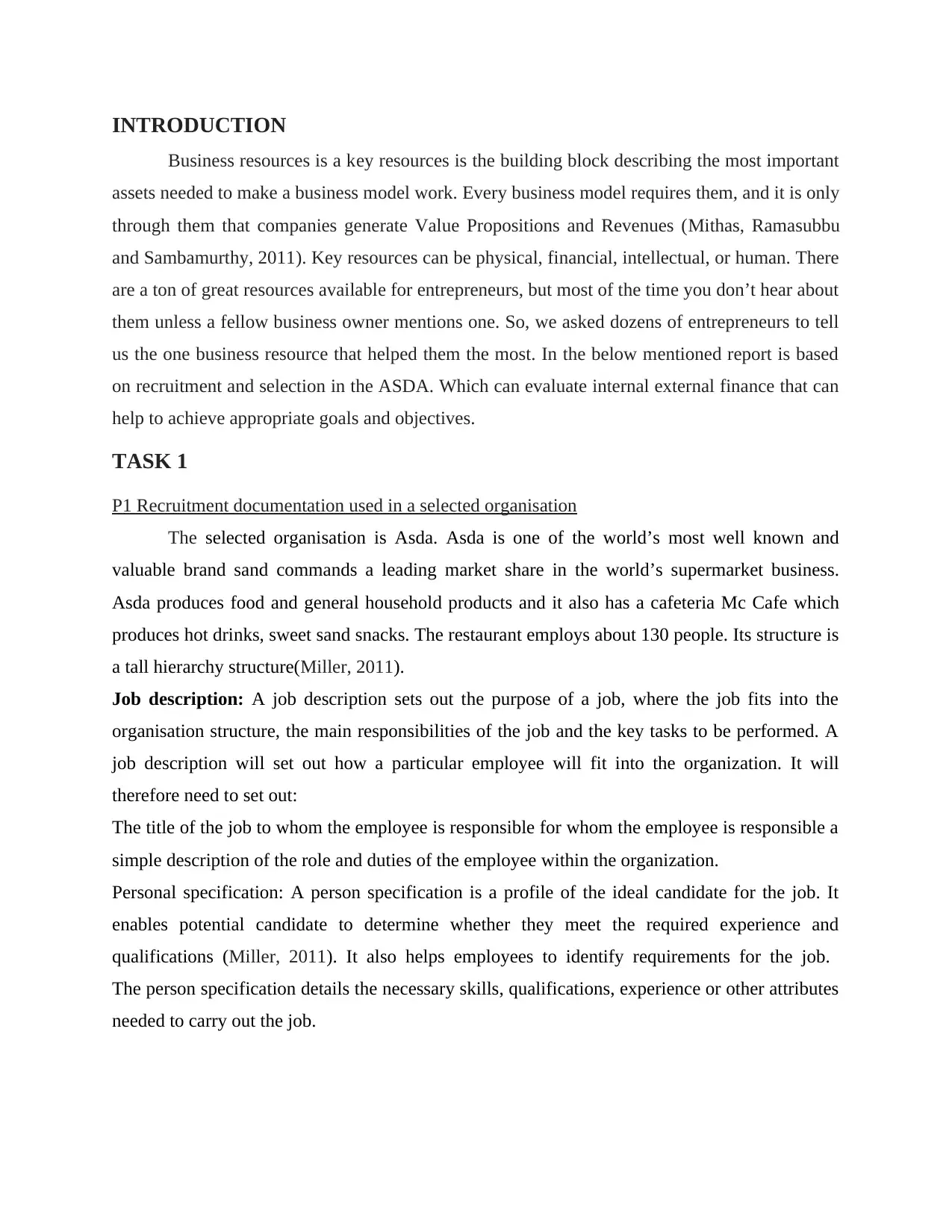
INTRODUCTION
Business resources is a key resources is the building block describing the most important
assets needed to make a business model work. Every business model requires them, and it is only
through them that companies generate Value Propositions and Revenues (Mithas, Ramasubbu
and Sambamurthy, 2011). Key resources can be physical, financial, intellectual, or human. There
are a ton of great resources available for entrepreneurs, but most of the time you don’t hear about
them unless a fellow business owner mentions one. So, we asked dozens of entrepreneurs to tell
us the one business resource that helped them the most. In the below mentioned report is based
on recruitment and selection in the ASDA. Which can evaluate internal external finance that can
help to achieve appropriate goals and objectives.
TASK 1
P1 Recruitment documentation used in a selected organisation
The selected organisation is Asda. Asda is one of the world’s most well known and
valuable brand sand commands a leading market share in the world’s supermarket business.
Asda produces food and general household products and it also has a cafeteria Mc Cafe which
produces hot drinks, sweet sand snacks. The restaurant employs about 130 people. Its structure is
a tall hierarchy structure(Miller, 2011).
Job description: A job description sets out the purpose of a job, where the job fits into the
organisation structure, the main responsibilities of the job and the key tasks to be performed. A
job description will set out how a particular employee will fit into the organization. It will
therefore need to set out:
The title of the job to whom the employee is responsible for whom the employee is responsible a
simple description of the role and duties of the employee within the organization.
Personal specification: A person specification is a profile of the ideal candidate for the job. It
enables potential candidate to determine whether they meet the required experience and
qualifications (Miller, 2011). It also helps employees to identify requirements for the job.
The person specification details the necessary skills, qualifications, experience or other attributes
needed to carry out the job.
Business resources is a key resources is the building block describing the most important
assets needed to make a business model work. Every business model requires them, and it is only
through them that companies generate Value Propositions and Revenues (Mithas, Ramasubbu
and Sambamurthy, 2011). Key resources can be physical, financial, intellectual, or human. There
are a ton of great resources available for entrepreneurs, but most of the time you don’t hear about
them unless a fellow business owner mentions one. So, we asked dozens of entrepreneurs to tell
us the one business resource that helped them the most. In the below mentioned report is based
on recruitment and selection in the ASDA. Which can evaluate internal external finance that can
help to achieve appropriate goals and objectives.
TASK 1
P1 Recruitment documentation used in a selected organisation
The selected organisation is Asda. Asda is one of the world’s most well known and
valuable brand sand commands a leading market share in the world’s supermarket business.
Asda produces food and general household products and it also has a cafeteria Mc Cafe which
produces hot drinks, sweet sand snacks. The restaurant employs about 130 people. Its structure is
a tall hierarchy structure(Miller, 2011).
Job description: A job description sets out the purpose of a job, where the job fits into the
organisation structure, the main responsibilities of the job and the key tasks to be performed. A
job description will set out how a particular employee will fit into the organization. It will
therefore need to set out:
The title of the job to whom the employee is responsible for whom the employee is responsible a
simple description of the role and duties of the employee within the organization.
Personal specification: A person specification is a profile of the ideal candidate for the job. It
enables potential candidate to determine whether they meet the required experience and
qualifications (Miller, 2011). It also helps employees to identify requirements for the job.
The person specification details the necessary skills, qualifications, experience or other attributes
needed to carry out the job.
⊘ This is a preview!⊘
Do you want full access?
Subscribe today to unlock all pages.

Trusted by 1+ million students worldwide
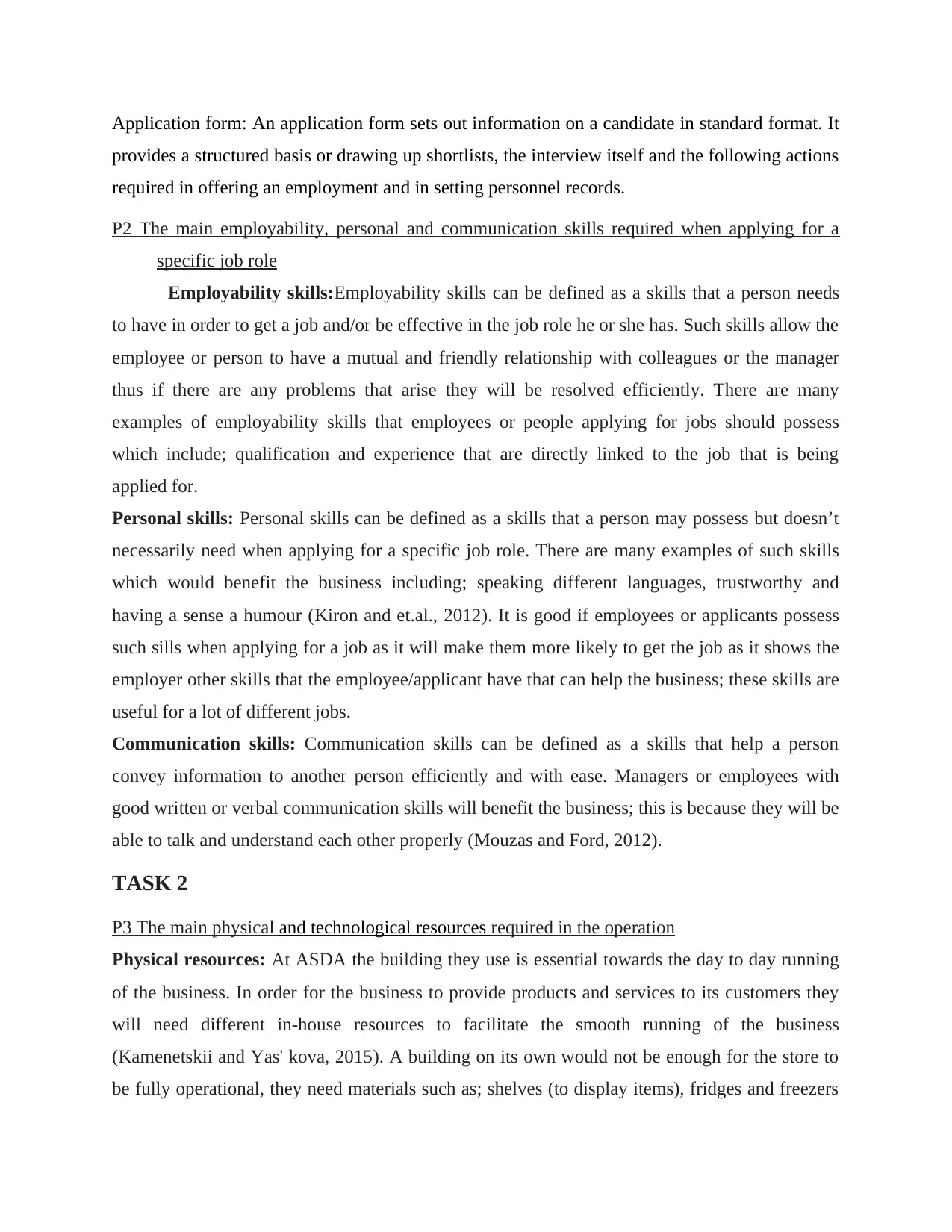
Application form: An application form sets out information on a candidate in standard format. It
provides a structured basis or drawing up shortlists, the interview itself and the following actions
required in offering an employment and in setting personnel records.
P2 The main employability, personal and communication skills required when applying for a
specific job role
Employability skills:Employability skills can be defined as a skills that a person needs
to have in order to get a job and/or be effective in the job role he or she has. Such skills allow the
employee or person to have a mutual and friendly relationship with colleagues or the manager
thus if there are any problems that arise they will be resolved efficiently. There are many
examples of employability skills that employees or people applying for jobs should possess
which include; qualification and experience that are directly linked to the job that is being
applied for.
Personal skills: Personal skills can be defined as a skills that a person may possess but doesn’t
necessarily need when applying for a specific job role. There are many examples of such skills
which would benefit the business including; speaking different languages, trustworthy and
having a sense a humour (Kiron and et.al., 2012). It is good if employees or applicants possess
such sills when applying for a job as it will make them more likely to get the job as it shows the
employer other skills that the employee/applicant have that can help the business; these skills are
useful for a lot of different jobs.
Communication skills: Communication skills can be defined as a skills that help a person
convey information to another person efficiently and with ease. Managers or employees with
good written or verbal communication skills will benefit the business; this is because they will be
able to talk and understand each other properly (Mouzas and Ford, 2012).
TASK 2
P3 The main physical and technological resources required in the operation
Physical resources: At ASDA the building they use is essential towards the day to day running
of the business. In order for the business to provide products and services to its customers they
will need different in-house resources to facilitate the smooth running of the business
(Kamenetskii and Yas' kova, 2015). A building on its own would not be enough for the store to
be fully operational, they need materials such as; shelves (to display items), fridges and freezers
provides a structured basis or drawing up shortlists, the interview itself and the following actions
required in offering an employment and in setting personnel records.
P2 The main employability, personal and communication skills required when applying for a
specific job role
Employability skills:Employability skills can be defined as a skills that a person needs
to have in order to get a job and/or be effective in the job role he or she has. Such skills allow the
employee or person to have a mutual and friendly relationship with colleagues or the manager
thus if there are any problems that arise they will be resolved efficiently. There are many
examples of employability skills that employees or people applying for jobs should possess
which include; qualification and experience that are directly linked to the job that is being
applied for.
Personal skills: Personal skills can be defined as a skills that a person may possess but doesn’t
necessarily need when applying for a specific job role. There are many examples of such skills
which would benefit the business including; speaking different languages, trustworthy and
having a sense a humour (Kiron and et.al., 2012). It is good if employees or applicants possess
such sills when applying for a job as it will make them more likely to get the job as it shows the
employer other skills that the employee/applicant have that can help the business; these skills are
useful for a lot of different jobs.
Communication skills: Communication skills can be defined as a skills that help a person
convey information to another person efficiently and with ease. Managers or employees with
good written or verbal communication skills will benefit the business; this is because they will be
able to talk and understand each other properly (Mouzas and Ford, 2012).
TASK 2
P3 The main physical and technological resources required in the operation
Physical resources: At ASDA the building they use is essential towards the day to day running
of the business. In order for the business to provide products and services to its customers they
will need different in-house resources to facilitate the smooth running of the business
(Kamenetskii and Yas' kova, 2015). A building on its own would not be enough for the store to
be fully operational, they need materials such as; shelves (to display items), fridges and freezers
Paraphrase This Document
Need a fresh take? Get an instant paraphrase of this document with our AI Paraphraser
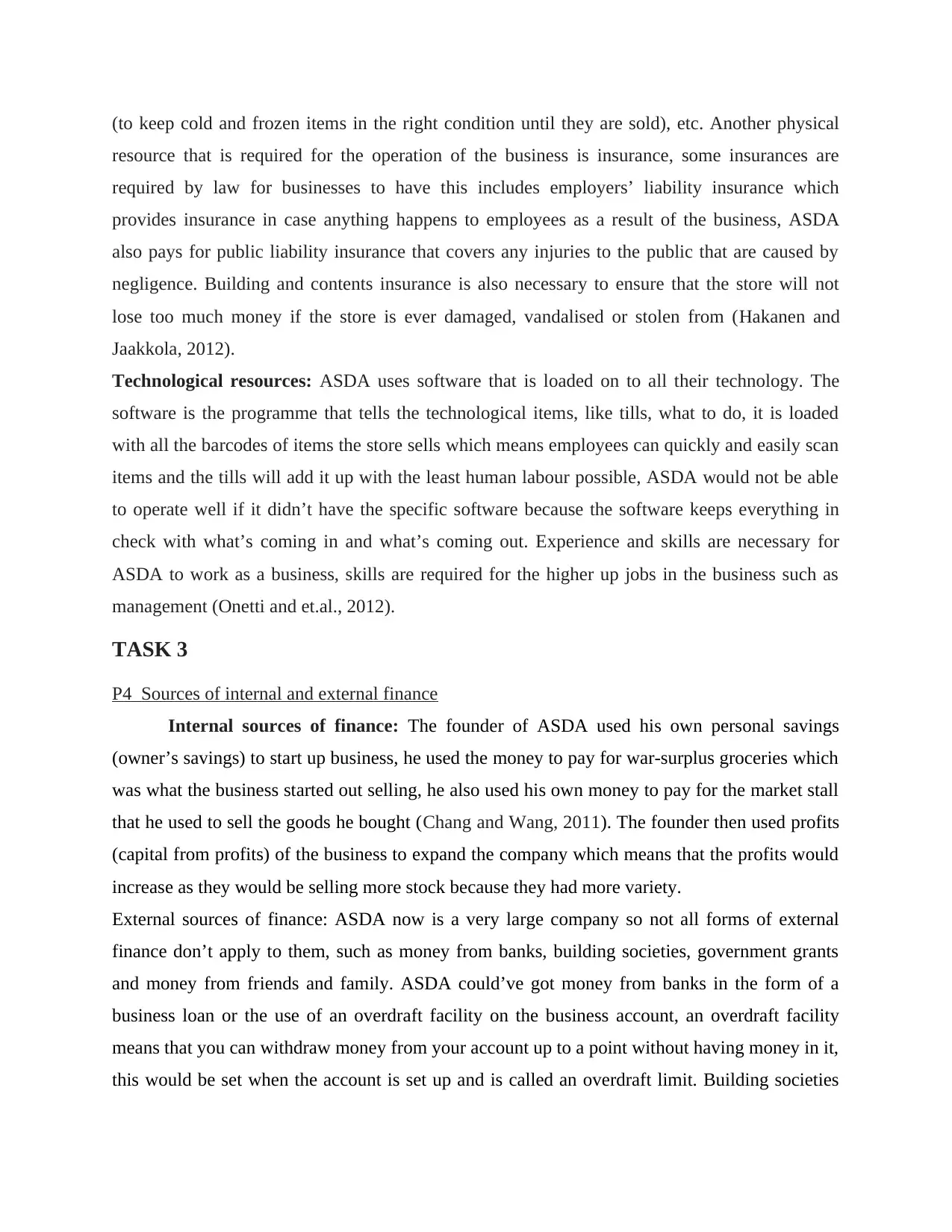
(to keep cold and frozen items in the right condition until they are sold), etc. Another physical
resource that is required for the operation of the business is insurance, some insurances are
required by law for businesses to have this includes employers’ liability insurance which
provides insurance in case anything happens to employees as a result of the business, ASDA
also pays for public liability insurance that covers any injuries to the public that are caused by
negligence. Building and contents insurance is also necessary to ensure that the store will not
lose too much money if the store is ever damaged, vandalised or stolen from (Hakanen and
Jaakkola, 2012).
Technological resources: ASDA uses software that is loaded on to all their technology. The
software is the programme that tells the technological items, like tills, what to do, it is loaded
with all the barcodes of items the store sells which means employees can quickly and easily scan
items and the tills will add it up with the least human labour possible, ASDA would not be able
to operate well if it didn’t have the specific software because the software keeps everything in
check with what’s coming in and what’s coming out. Experience and skills are necessary for
ASDA to work as a business, skills are required for the higher up jobs in the business such as
management (Onetti and et.al., 2012).
TASK 3
P4 Sources of internal and external finance
Internal sources of finance: The founder of ASDA used his own personal savings
(owner’s savings) to start up business, he used the money to pay for war-surplus groceries which
was what the business started out selling, he also used his own money to pay for the market stall
that he used to sell the goods he bought (Chang and Wang, 2011). The founder then used profits
(capital from profits) of the business to expand the company which means that the profits would
increase as they would be selling more stock because they had more variety.
External sources of finance: ASDA now is a very large company so not all forms of external
finance don’t apply to them, such as money from banks, building societies, government grants
and money from friends and family. ASDA could’ve got money from banks in the form of a
business loan or the use of an overdraft facility on the business account, an overdraft facility
means that you can withdraw money from your account up to a point without having money in it,
this would be set when the account is set up and is called an overdraft limit. Building societies
resource that is required for the operation of the business is insurance, some insurances are
required by law for businesses to have this includes employers’ liability insurance which
provides insurance in case anything happens to employees as a result of the business, ASDA
also pays for public liability insurance that covers any injuries to the public that are caused by
negligence. Building and contents insurance is also necessary to ensure that the store will not
lose too much money if the store is ever damaged, vandalised or stolen from (Hakanen and
Jaakkola, 2012).
Technological resources: ASDA uses software that is loaded on to all their technology. The
software is the programme that tells the technological items, like tills, what to do, it is loaded
with all the barcodes of items the store sells which means employees can quickly and easily scan
items and the tills will add it up with the least human labour possible, ASDA would not be able
to operate well if it didn’t have the specific software because the software keeps everything in
check with what’s coming in and what’s coming out. Experience and skills are necessary for
ASDA to work as a business, skills are required for the higher up jobs in the business such as
management (Onetti and et.al., 2012).
TASK 3
P4 Sources of internal and external finance
Internal sources of finance: The founder of ASDA used his own personal savings
(owner’s savings) to start up business, he used the money to pay for war-surplus groceries which
was what the business started out selling, he also used his own money to pay for the market stall
that he used to sell the goods he bought (Chang and Wang, 2011). The founder then used profits
(capital from profits) of the business to expand the company which means that the profits would
increase as they would be selling more stock because they had more variety.
External sources of finance: ASDA now is a very large company so not all forms of external
finance don’t apply to them, such as money from banks, building societies, government grants
and money from friends and family. ASDA could’ve got money from banks in the form of a
business loan or the use of an overdraft facility on the business account, an overdraft facility
means that you can withdraw money from your account up to a point without having money in it,
this would be set when the account is set up and is called an overdraft limit. Building societies
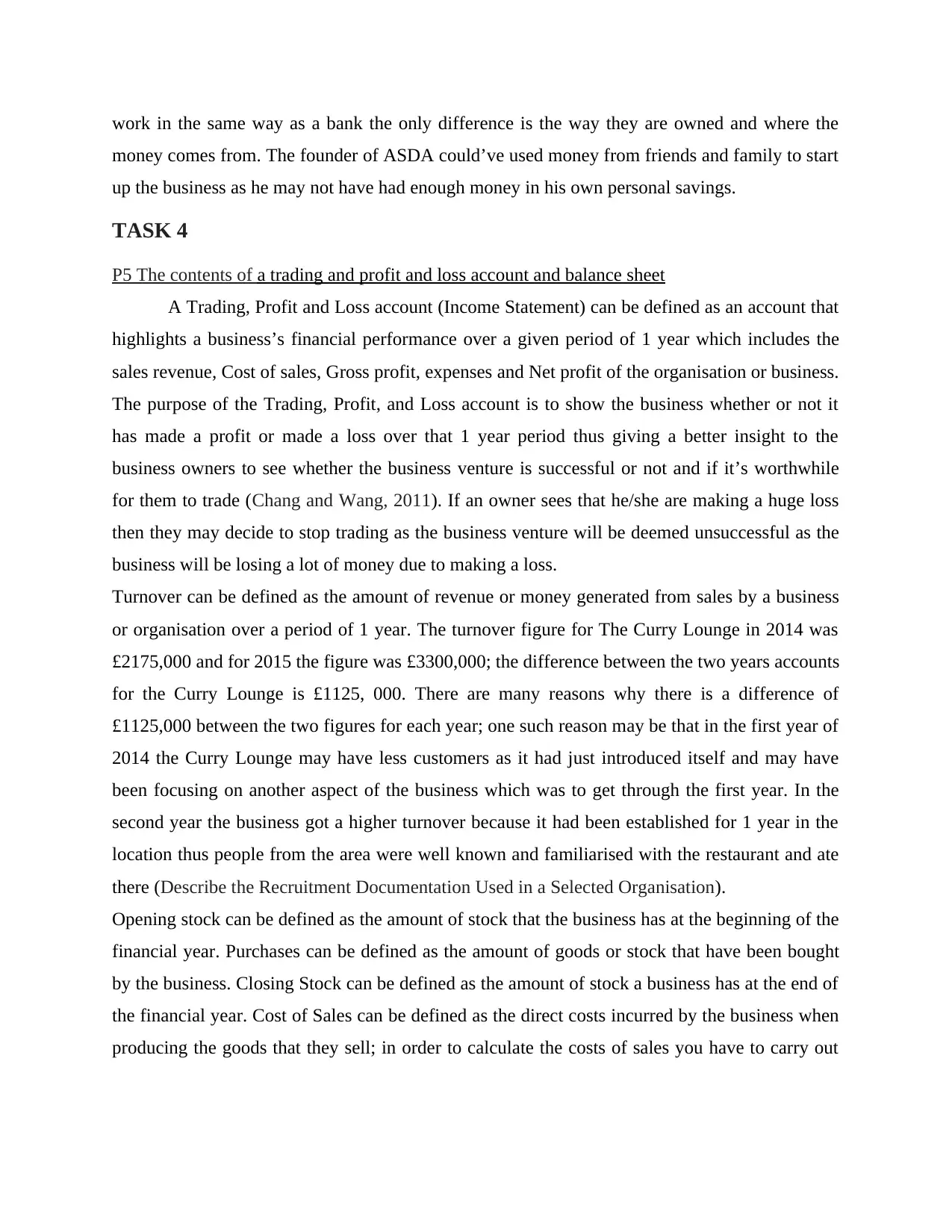
work in the same way as a bank the only difference is the way they are owned and where the
money comes from. The founder of ASDA could’ve used money from friends and family to start
up the business as he may not have had enough money in his own personal savings.
TASK 4
P5 The contents of a trading and profit and loss account and balance sheet
A Trading, Profit and Loss account (Income Statement) can be defined as an account that
highlights a business’s financial performance over a given period of 1 year which includes the
sales revenue, Cost of sales, Gross profit, expenses and Net profit of the organisation or business.
The purpose of the Trading, Profit, and Loss account is to show the business whether or not it
has made a profit or made a loss over that 1 year period thus giving a better insight to the
business owners to see whether the business venture is successful or not and if it’s worthwhile
for them to trade (Chang and Wang, 2011). If an owner sees that he/she are making a huge loss
then they may decide to stop trading as the business venture will be deemed unsuccessful as the
business will be losing a lot of money due to making a loss.
Turnover can be defined as the amount of revenue or money generated from sales by a business
or organisation over a period of 1 year. The turnover figure for The Curry Lounge in 2014 was
£2175,000 and for 2015 the figure was £3300,000; the difference between the two years accounts
for the Curry Lounge is £1125, 000. There are many reasons why there is a difference of
£1125,000 between the two figures for each year; one such reason may be that in the first year of
2014 the Curry Lounge may have less customers as it had just introduced itself and may have
been focusing on another aspect of the business which was to get through the first year. In the
second year the business got a higher turnover because it had been established for 1 year in the
location thus people from the area were well known and familiarised with the restaurant and ate
there (Describe the Recruitment Documentation Used in a Selected Organisation).
Opening stock can be defined as the amount of stock that the business has at the beginning of the
financial year. Purchases can be defined as the amount of goods or stock that have been bought
by the business. Closing Stock can be defined as the amount of stock a business has at the end of
the financial year. Cost of Sales can be defined as the direct costs incurred by the business when
producing the goods that they sell; in order to calculate the costs of sales you have to carry out
money comes from. The founder of ASDA could’ve used money from friends and family to start
up the business as he may not have had enough money in his own personal savings.
TASK 4
P5 The contents of a trading and profit and loss account and balance sheet
A Trading, Profit and Loss account (Income Statement) can be defined as an account that
highlights a business’s financial performance over a given period of 1 year which includes the
sales revenue, Cost of sales, Gross profit, expenses and Net profit of the organisation or business.
The purpose of the Trading, Profit, and Loss account is to show the business whether or not it
has made a profit or made a loss over that 1 year period thus giving a better insight to the
business owners to see whether the business venture is successful or not and if it’s worthwhile
for them to trade (Chang and Wang, 2011). If an owner sees that he/she are making a huge loss
then they may decide to stop trading as the business venture will be deemed unsuccessful as the
business will be losing a lot of money due to making a loss.
Turnover can be defined as the amount of revenue or money generated from sales by a business
or organisation over a period of 1 year. The turnover figure for The Curry Lounge in 2014 was
£2175,000 and for 2015 the figure was £3300,000; the difference between the two years accounts
for the Curry Lounge is £1125, 000. There are many reasons why there is a difference of
£1125,000 between the two figures for each year; one such reason may be that in the first year of
2014 the Curry Lounge may have less customers as it had just introduced itself and may have
been focusing on another aspect of the business which was to get through the first year. In the
second year the business got a higher turnover because it had been established for 1 year in the
location thus people from the area were well known and familiarised with the restaurant and ate
there (Describe the Recruitment Documentation Used in a Selected Organisation).
Opening stock can be defined as the amount of stock that the business has at the beginning of the
financial year. Purchases can be defined as the amount of goods or stock that have been bought
by the business. Closing Stock can be defined as the amount of stock a business has at the end of
the financial year. Cost of Sales can be defined as the direct costs incurred by the business when
producing the goods that they sell; in order to calculate the costs of sales you have to carry out
⊘ This is a preview!⊘
Do you want full access?
Subscribe today to unlock all pages.

Trusted by 1+ million students worldwide
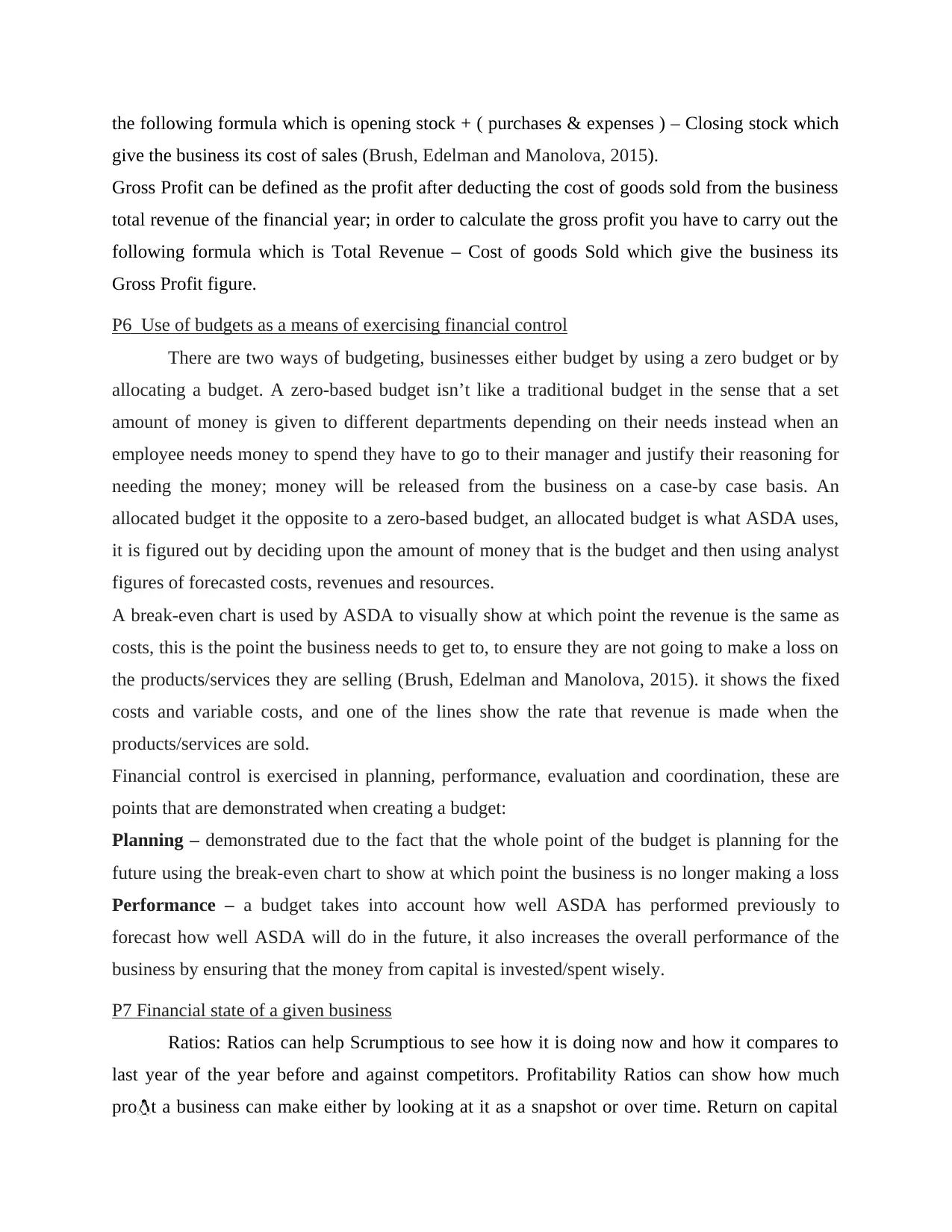
the following formula which is opening stock + ( purchases & expenses ) – Closing stock which
give the business its cost of sales (Brush, Edelman and Manolova, 2015).
Gross Profit can be defined as the profit after deducting the cost of goods sold from the business
total revenue of the financial year; in order to calculate the gross profit you have to carry out the
following formula which is Total Revenue – Cost of goods Sold which give the business its
Gross Profit figure.
P6 Use of budgets as a means of exercising financial control
There are two ways of budgeting, businesses either budget by using a zero budget or by
allocating a budget. A zero-based budget isn’t like a traditional budget in the sense that a set
amount of money is given to different departments depending on their needs instead when an
employee needs money to spend they have to go to their manager and justify their reasoning for
needing the money; money will be released from the business on a case-by case basis. An
allocated budget it the opposite to a zero-based budget, an allocated budget is what ASDA uses,
it is figured out by deciding upon the amount of money that is the budget and then using analyst
figures of forecasted costs, revenues and resources.
A break-even chart is used by ASDA to visually show at which point the revenue is the same as
costs, this is the point the business needs to get to, to ensure they are not going to make a loss on
the products/services they are selling (Brush, Edelman and Manolova, 2015). it shows the fixed
costs and variable costs, and one of the lines show the rate that revenue is made when the
products/services are sold.
Financial control is exercised in planning, performance, evaluation and coordination, these are
points that are demonstrated when creating a budget:
Planning – demonstrated due to the fact that the whole point of the budget is planning for the
future using the break-even chart to show at which point the business is no longer making a loss
Performance – a budget takes into account how well ASDA has performed previously to
forecast how well ASDA will do in the future, it also increases the overall performance of the
business by ensuring that the money from capital is invested/spent wisely.
P7 Financial state of a given business
Ratios: Ratios can help Scrumptious to see how it is doing now and how it compares to
last year of the year before and against competitors. Profitability Ratios can show how much
pro t a business can make either by looking at it as a snapshot or over time. Return on capital
give the business its cost of sales (Brush, Edelman and Manolova, 2015).
Gross Profit can be defined as the profit after deducting the cost of goods sold from the business
total revenue of the financial year; in order to calculate the gross profit you have to carry out the
following formula which is Total Revenue – Cost of goods Sold which give the business its
Gross Profit figure.
P6 Use of budgets as a means of exercising financial control
There are two ways of budgeting, businesses either budget by using a zero budget or by
allocating a budget. A zero-based budget isn’t like a traditional budget in the sense that a set
amount of money is given to different departments depending on their needs instead when an
employee needs money to spend they have to go to their manager and justify their reasoning for
needing the money; money will be released from the business on a case-by case basis. An
allocated budget it the opposite to a zero-based budget, an allocated budget is what ASDA uses,
it is figured out by deciding upon the amount of money that is the budget and then using analyst
figures of forecasted costs, revenues and resources.
A break-even chart is used by ASDA to visually show at which point the revenue is the same as
costs, this is the point the business needs to get to, to ensure they are not going to make a loss on
the products/services they are selling (Brush, Edelman and Manolova, 2015). it shows the fixed
costs and variable costs, and one of the lines show the rate that revenue is made when the
products/services are sold.
Financial control is exercised in planning, performance, evaluation and coordination, these are
points that are demonstrated when creating a budget:
Planning – demonstrated due to the fact that the whole point of the budget is planning for the
future using the break-even chart to show at which point the business is no longer making a loss
Performance – a budget takes into account how well ASDA has performed previously to
forecast how well ASDA will do in the future, it also increases the overall performance of the
business by ensuring that the money from capital is invested/spent wisely.
P7 Financial state of a given business
Ratios: Ratios can help Scrumptious to see how it is doing now and how it compares to
last year of the year before and against competitors. Profitability Ratios can show how much
pro t a business can make either by looking at it as a snapshot or over time. Return on capital
Paraphrase This Document
Need a fresh take? Get an instant paraphrase of this document with our AI Paraphraser

employed Gross profit percentage This shows the positive percentage that comes into the
business. The percentage calculated presents the turnover such as sales and any other income that
a business gets. The gross profit margin presents how well the business is managing its purchase
of stock. If like engineering business increased over the year, it would have meant that it is doing
well controlling the cost of their purchases but has turned out as opposite (Bruneel and et.al.,
2012).
Net profit:This is where the negativity of the profit is calculated by the gross profit minus other
expenses that the business has made like rent or advertising. The calculation can also be seen as a
step further by considering the profit at a percentage of turnover after all the expenses are made
including the other one.
Return on capital employed: This is the third option for calculating profitability within the
business. It is worked out by considering the net profit as a percentage of the capital employed
by the business. The reason this ratio is useful for the business is so that the can see the amount
of money an investor is receiving back on their capital as a percentage.
CONCLUSION
In the above mention report are define financial statement and profit and loss account
which can evaluate effective position of the company. Business resources can be identify the
external and internal finance to improve their performance of the company.
business. The percentage calculated presents the turnover such as sales and any other income that
a business gets. The gross profit margin presents how well the business is managing its purchase
of stock. If like engineering business increased over the year, it would have meant that it is doing
well controlling the cost of their purchases but has turned out as opposite (Bruneel and et.al.,
2012).
Net profit:This is where the negativity of the profit is calculated by the gross profit minus other
expenses that the business has made like rent or advertising. The calculation can also be seen as a
step further by considering the profit at a percentage of turnover after all the expenses are made
including the other one.
Return on capital employed: This is the third option for calculating profitability within the
business. It is worked out by considering the net profit as a percentage of the capital employed
by the business. The reason this ratio is useful for the business is so that the can see the amount
of money an investor is receiving back on their capital as a percentage.
CONCLUSION
In the above mention report are define financial statement and profit and loss account
which can evaluate effective position of the company. Business resources can be identify the
external and internal finance to improve their performance of the company.
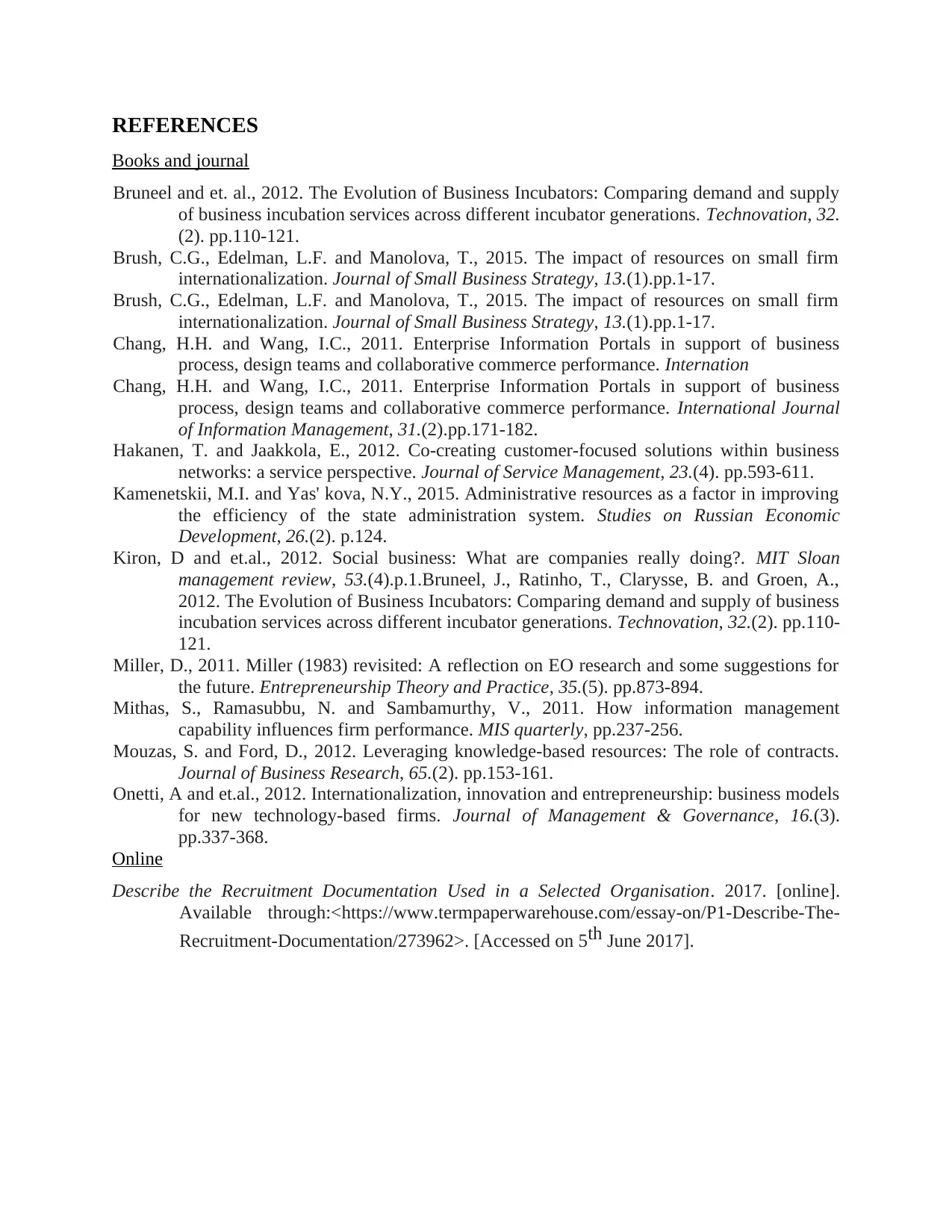
REFERENCES
Books and journal
Bruneel and et. al., 2012. The Evolution of Business Incubators: Comparing demand and supply
of business incubation services across different incubator generations. Technovation, 32.
(2). pp.110-121.
Brush, C.G., Edelman, L.F. and Manolova, T., 2015. The impact of resources on small firm
internationalization. Journal of Small Business Strategy, 13.(1).pp.1-17.
Brush, C.G., Edelman, L.F. and Manolova, T., 2015. The impact of resources on small firm
internationalization. Journal of Small Business Strategy, 13.(1).pp.1-17.
Chang, H.H. and Wang, I.C., 2011. Enterprise Information Portals in support of business
process, design teams and collaborative commerce performance. Internation
Chang, H.H. and Wang, I.C., 2011. Enterprise Information Portals in support of business
process, design teams and collaborative commerce performance. International Journal
of Information Management, 31.(2).pp.171-182.
Hakanen, T. and Jaakkola, E., 2012. Co-creating customer-focused solutions within business
networks: a service perspective. Journal of Service Management, 23.(4). pp.593-611.
Kamenetskii, M.I. and Yas' kova, N.Y., 2015. Administrative resources as a factor in improving
the efficiency of the state administration system. Studies on Russian Economic
Development, 26.(2). p.124.
Kiron, D and et.al., 2012. Social business: What are companies really doing?. MIT Sloan
management review, 53.(4).p.1.Bruneel, J., Ratinho, T., Clarysse, B. and Groen, A.,
2012. The Evolution of Business Incubators: Comparing demand and supply of business
incubation services across different incubator generations. Technovation, 32.(2). pp.110-
121.
Miller, D., 2011. Miller (1983) revisited: A reflection on EO research and some suggestions for
the future. Entrepreneurship Theory and Practice, 35.(5). pp.873-894.
Mithas, S., Ramasubbu, N. and Sambamurthy, V., 2011. How information management
capability influences firm performance. MIS quarterly, pp.237-256.
Mouzas, S. and Ford, D., 2012. Leveraging knowledge-based resources: The role of contracts.
Journal of Business Research, 65.(2). pp.153-161.
Onetti, A and et.al., 2012. Internationalization, innovation and entrepreneurship: business models
for new technology-based firms. Journal of Management & Governance, 16.(3).
pp.337-368.
Online
Describe the Recruitment Documentation Used in a Selected Organisation. 2017. [online].
Available through:<https://www.termpaperwarehouse.com/essay-on/P1-Describe-The-
Recruitment-Documentation/273962>. [Accessed on 5th June 2017].
Books and journal
Bruneel and et. al., 2012. The Evolution of Business Incubators: Comparing demand and supply
of business incubation services across different incubator generations. Technovation, 32.
(2). pp.110-121.
Brush, C.G., Edelman, L.F. and Manolova, T., 2015. The impact of resources on small firm
internationalization. Journal of Small Business Strategy, 13.(1).pp.1-17.
Brush, C.G., Edelman, L.F. and Manolova, T., 2015. The impact of resources on small firm
internationalization. Journal of Small Business Strategy, 13.(1).pp.1-17.
Chang, H.H. and Wang, I.C., 2011. Enterprise Information Portals in support of business
process, design teams and collaborative commerce performance. Internation
Chang, H.H. and Wang, I.C., 2011. Enterprise Information Portals in support of business
process, design teams and collaborative commerce performance. International Journal
of Information Management, 31.(2).pp.171-182.
Hakanen, T. and Jaakkola, E., 2012. Co-creating customer-focused solutions within business
networks: a service perspective. Journal of Service Management, 23.(4). pp.593-611.
Kamenetskii, M.I. and Yas' kova, N.Y., 2015. Administrative resources as a factor in improving
the efficiency of the state administration system. Studies on Russian Economic
Development, 26.(2). p.124.
Kiron, D and et.al., 2012. Social business: What are companies really doing?. MIT Sloan
management review, 53.(4).p.1.Bruneel, J., Ratinho, T., Clarysse, B. and Groen, A.,
2012. The Evolution of Business Incubators: Comparing demand and supply of business
incubation services across different incubator generations. Technovation, 32.(2). pp.110-
121.
Miller, D., 2011. Miller (1983) revisited: A reflection on EO research and some suggestions for
the future. Entrepreneurship Theory and Practice, 35.(5). pp.873-894.
Mithas, S., Ramasubbu, N. and Sambamurthy, V., 2011. How information management
capability influences firm performance. MIS quarterly, pp.237-256.
Mouzas, S. and Ford, D., 2012. Leveraging knowledge-based resources: The role of contracts.
Journal of Business Research, 65.(2). pp.153-161.
Onetti, A and et.al., 2012. Internationalization, innovation and entrepreneurship: business models
for new technology-based firms. Journal of Management & Governance, 16.(3).
pp.337-368.
Online
Describe the Recruitment Documentation Used in a Selected Organisation. 2017. [online].
Available through:<https://www.termpaperwarehouse.com/essay-on/P1-Describe-The-
Recruitment-Documentation/273962>. [Accessed on 5th June 2017].
⊘ This is a preview!⊘
Do you want full access?
Subscribe today to unlock all pages.

Trusted by 1+ million students worldwide
1 out of 9
Related Documents
Your All-in-One AI-Powered Toolkit for Academic Success.
+13062052269
info@desklib.com
Available 24*7 on WhatsApp / Email
![[object Object]](/_next/static/media/star-bottom.7253800d.svg)
Unlock your academic potential
Copyright © 2020–2025 A2Z Services. All Rights Reserved. Developed and managed by ZUCOL.





